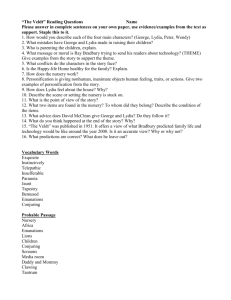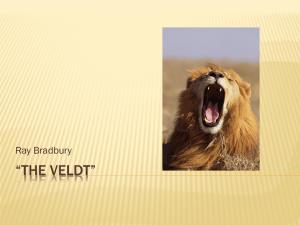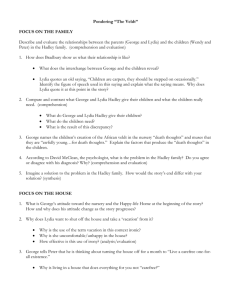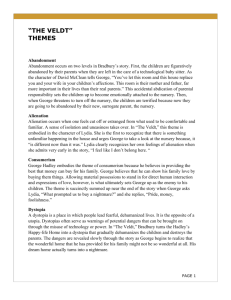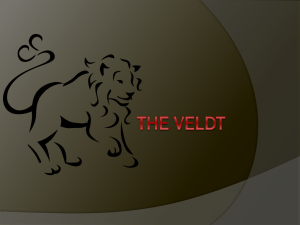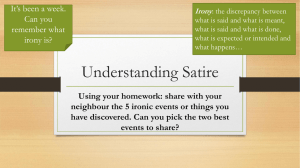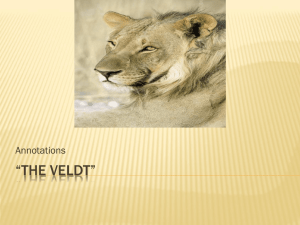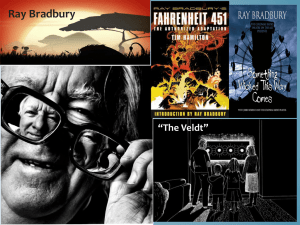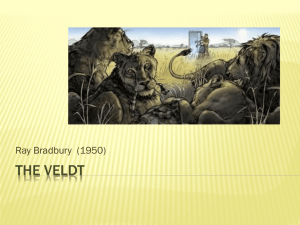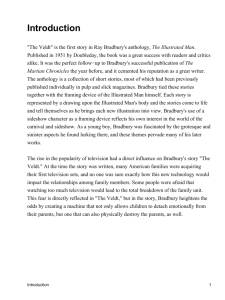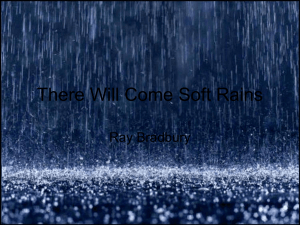The Veldt 2
advertisement
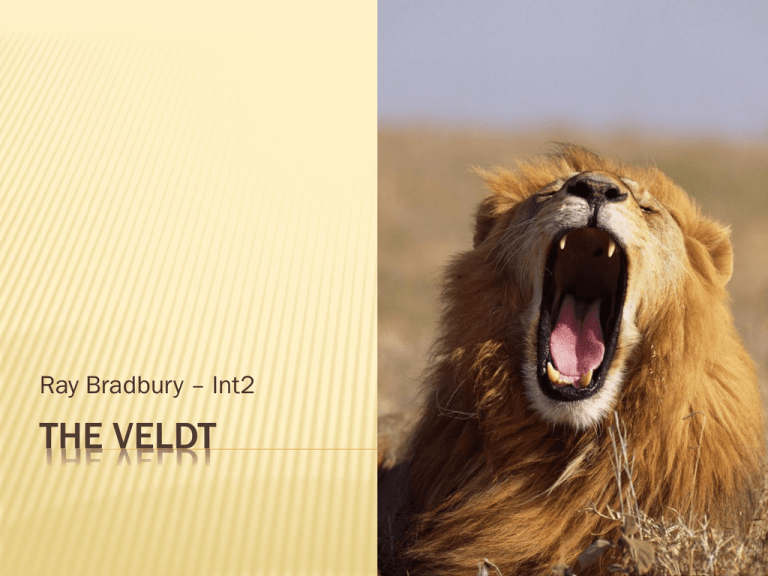
Ray Bradbury – Int2 THE VELDT WHAT’S IN THE TITLE? A VELDT – A NAME FOR AFRICAN PLAINS GEORGE HADLEY George represents consumerism (love of shopping and material things) in the story. His way of showing love is buying things for his family and this ends up in him buying the “Happylife Home” which turns his spoilt children against him His unshakeable belief that illusion cannot become reality is what kills him and Lydia. LYDIA HADLEY Lydia Hadley is the character through which Bradbury conveys the uneasiness about the house and isolation from her family “I feel like I don’t belong here” Lydia understands the destructive nature of the house before George and understands it has become a DYSTOPIA THE CHILDREN The children’s names are borrowed from J.M.Barrie’s “Peter Pan” – this draws parallels with the idea of “Neverland” which is free from adult control and where children never grow up. The final ending is ironic and symbolic as the children eat a “picnic lunch” – this is an image of innocence with Wendy already replacing her mother by offering a cup of tea yet this innocent scene is hiding their parents’ brutal murder. When Wendy and Peter return home Bradbury describes them as having "cheeks like peppermint candy, eyes like bright blue agate marbles." The similes here serve to emphasize the fact that these are two cute, energetic children who might be found in any typical middle-American family. PETER Peter is measured, cold and cruel “I don’t think you’d better consider it any more, Father.” Bradbury effectively creates a calculating, creepy ten year old boy we understand to be well capable of masterminding his parents’ murder. THEMES Abandonment Alienation Consumerism Illusion vs Reality Man vs Machine Revenge ALIENATION Alienation occurs when one feels cut off or estranged from what used to be comfortable and familiar. A sense of isolation and uneasiness takes over. In "The Veldt," this theme is embodied in the character of Lydia. She is the first to recognize that there is something unfamiliar happening in the house and urges George to take a look at the nursery because, it "is different now than it was." Lydia clearly recognizes her own feelings of alienation when she admits very early in the story, "I feel like I don't belong here. " ABANDONMENT Abandonment occurs on two levels in Bradbury's story. First, the children are figuratively abandoned by their parents when they are left in the care of a technological baby sitter. As the character of David McClean tells George, "You've let this room and this house replace you and your wife in your children's affections. This room is their mother and father, far more important in their lives than their real parents." This accidental abdication of parental responsibility sets the children up to become emotionally attached to the nursery. Then, when George threatens to turn off the nursery, the children are terrified because now they are going to be abandoned by their new, surrogate parent, the nursery. CONSUMERISM George Hadley embodies the theme of consumerism because he believes in providing the best that money can buy for his family. George believes that he can show his family love by buying them things. Allowing material possessions to stand in for direct human interaction and expressions of love, however, is what ultimately sets George up as the enemy to his children. The theme is succinctly summed up near the end of the story when George asks Lydia, "What prompted us to buy a nightmare?" and she replies, "Pride, money, foolishness." ILLUSION VS REALITY The ability to distinguish illusion from reality and the co-mingling of the two is a key theme in "The Veldt." George ultimately agrees to turn on the nursery one more time, thus putting himself and his wife in jeopardy, because he believes that there is a definite distinction between illusion and reality. Something that is an illusion can never become truly "real." This is why George believes that the lions pose no real threat. They are only part of a machine that creates wonderful illusions, "Walls, Lydia, remember; crystal walls, that's all they are. Oh, they look real, I must admit-Africa in your parlor-but it's all dimensional superactionary, supersensitive color film and mental tape film behind glass screens." What George fails to understand is, in the world of this short story, illusion and reality are transposable. One can become the other at any moment. MAN VS MACHINE One of the major conflicts in Bradbury's story is that of man versus machine. The story is built around the struggle to control and direct the destructive power of the nursery's technology. Whoever controls the machine will have the ultimate power. In this story man is destroyed by the machines in two ways: not only are George and Lydia murdered by the nursery's technology, but the children's humanity is also destroyed. By identifying so closely with the nursery, the children have become less than human. They feel no guilt, remorse or regret when their parents die, and it is clear that they have become as cold and emotionless as the machinery that controls the nursery. REVENGE "The Veldt" can be read as the ultimate children's revenge story. Children often feel powerless against adults and create elaborate fantasies in which they have the power to conquer any adult who refuses to give them what they want. George triggers these fantasies in Peter and Wendy when he forbids them to take the rocket to New York. The children are used to getting their own way, and they become very angry when they cannot have what they want. Thus the cycle of revenge is set in motion. EXAMPLE TOPIC SENTENCE A way in which the key theme of __________ is conveyed is when the character of ________ (then refer to key incident) ___________ This is shown when _______ says “______________________________” TODAY’S LESSON Holiday homework is DUE Peer assessment of essays using SQA criteria and essay checklists Veldt notes Add these key incidents to your mindmaps FORESHADOWING Foreshadowing is a technique in which a writer drops hints about what is to happen later in a story. FORESHADOWING Early in the story when the parents, George and Lydia, are in the nursery looking out at the lions and the carcass that they are eating. They keep saying how they don't know what the animal that is being eaten is. Later on in the story it is revealed that the animal represented is in fact themselves. FORESHADOWING When G&L are being disrupted by screams coming from the nursery. Later on it is revealed that the screams that they are hearing are their own when they are killed in the nursery by the lions. The third piece of foreshadowing is expressed in two parts. At two points in the story the parents find old possessions of theirs in the nursery. The possessions that are found are George's old wallet and Lydia's old scarf. Both of the possessions are bloody and torn up when they find them, due to the fact that they have been torn up by the lions. This is also hinting at the inevitable demise of the parents in the nursery towards the end of the story FORESHADOWING The final form of foreshadowing in The Veldt is when the psychiatrist is in the nursery talking to George, as the two are looking out into the African Veldt scene he says, "Now I'm feeling persecuted... Let's get out of here. I never cared for these damned rooms. Make me nervous". Here Bradbury is clearly hinting at how unsafe the nursery really is. PERSONIFICATION The technique of personification involves attributing human characteristics to things that are not human. Bradbury uses this technique to great effect throughout "The Veldt." He personifies the nursery and the house itself by attributing emotions to these inanimate objects, '''I don't imagine the room will like being turned off,' said the father. 'Nothing likes to die-even a room. I wonder if it hates me for wanting to switch it off?'" By turning the house into a living, breathing entity through personification, Bradbury heightens the tension and the threat. Now the parents are not only fighting their children, they are also pitted against a technological monster that is working to destroy them. NARRATIVE STYLE The story is told from a third-person point of view which means the narrator does not directly take part in the story but reports the events to the reader. The narrator is closely aligned with the character of George Hadley, however. He follows George's movements throughout the house and does not usually break away to report on scenes in which George is not involved. The story only breaks this pattern at the end, when George and Lydia are already dead and the narrator continues to report on the scene between Wendy, Peter and David McClean. AMBIANCE This is the emotional style that spreads out a work of fiction. Bradbury is able to set up a tense oppressive ambiance in the story by being very descriptive through the dialogue. "The hot straw smell of lion grass, the cool green smell of the hidden water hole, the great rusty smell of animals, the smell of dust like a red paprika in the hot air." These lines create a certain atmosphere that you can clearly imagine and feel, as it also helps to add the sense of dread that comes from the storyline. Ambiance in the Veldt allows the reader to know before danger even strikes that something bad is bound to happen, and the story that they are reading is not a cheerful one. SYMBOLISM What do the following represent? SYMBOLISM IN THE VELDT The nursery/the house – symbolises technology outside of human control The lions symbolise strength – as the house grows in power the lions become more “real”. Lions also symbolise the ferocity of the children. The vultures in the story symbolise death – they are swooping over the seemingly innocent picnic at the end of the story. The heat symbolises the discomfort felt by George and Lydia The children’s names – Peter and Wendy – reminiscent of Peter Pan by J.M.Barrie symbolise their longing for a world free of adult control. ESSAY QUESTION 5. Choose a novel or a short story which deals with the effects of evil or war or deceit or a breakdown in society or a breakdown in relationship(s). Show how any of these negative pressures affects the main character in the novel or short story and go on to show whether or not she or he tackles it successfully. PROSE Choose a novel or short story which deals with an important human issue: for example, poverty, war, family conflict, injustice, or any other issue you regard as important. State what the issue is and show how the characters cope with the issue in the course of the novel or short story. P.E.A.R Bradbury cleverly builds up this sense of foreboding by a variety of techniques. He focuses on the colour yellow for the sun and the colour of the lions . The hidden "odorophonics" in the nursery let us imagine the smell of the fresh meat coming from "the panting, dripping mouths of the lions". Vultures cast shadows on the landscape, both literally and metaphorically, a device which is used to great effect both at the start and the end of the story to create its circular structure. These are obviously associated with death, normally of animals, but at the shocking end of the story the deaths are those of George and Lydia.
